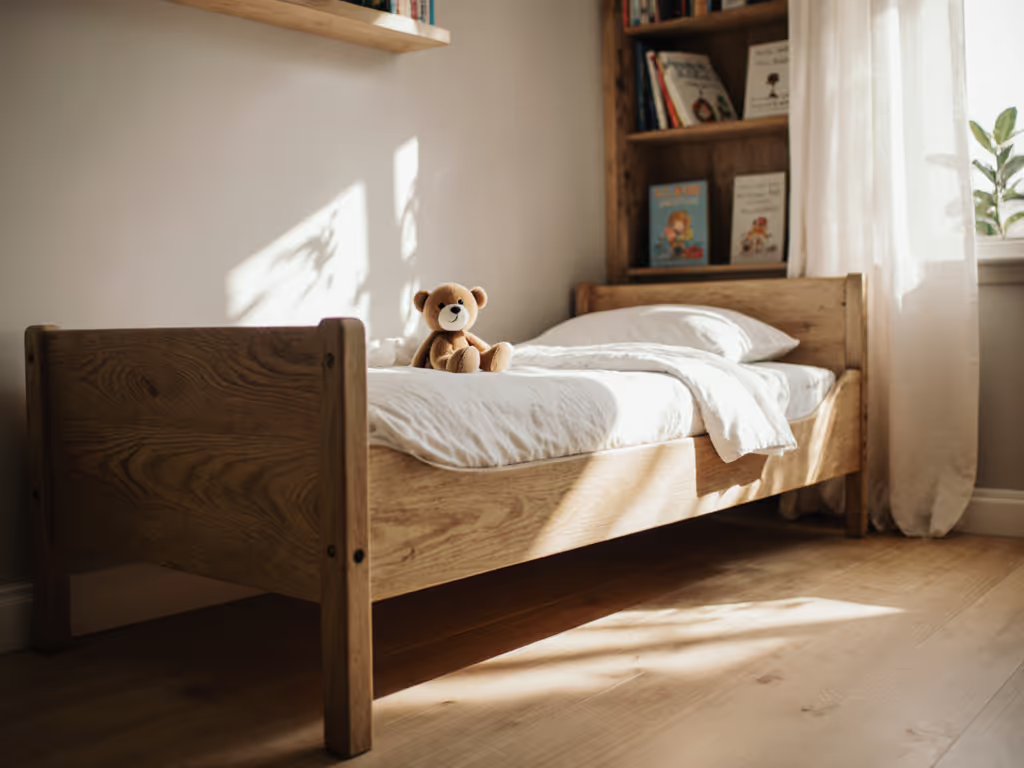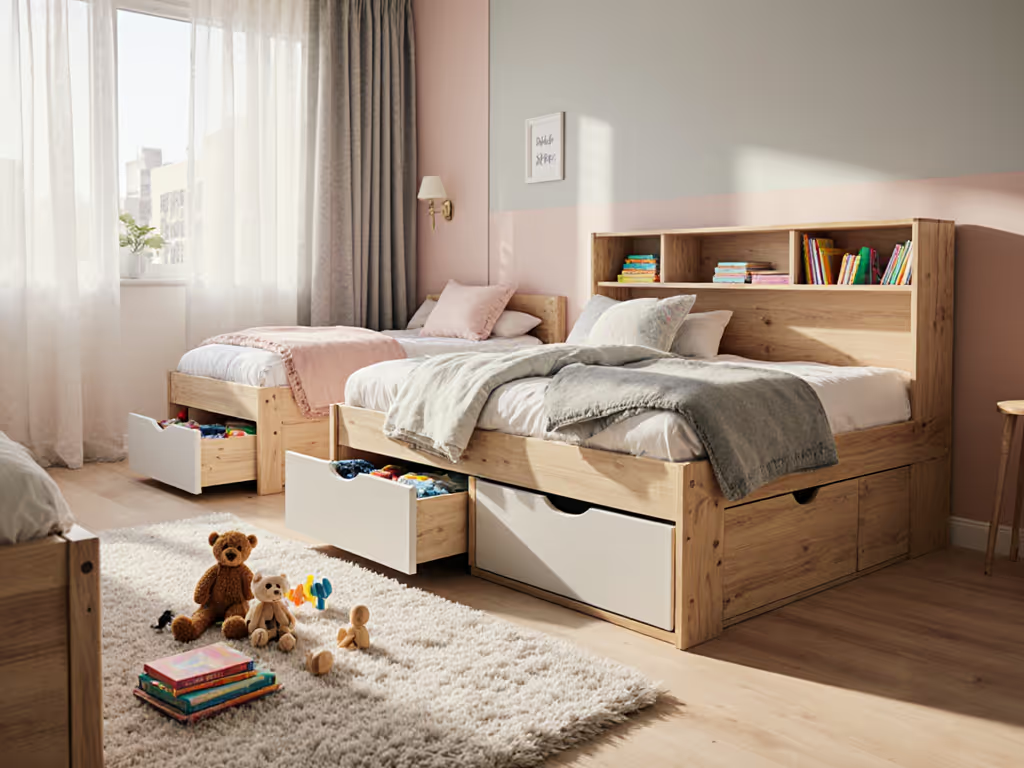
Convertible Beds Explained: Space Saving for Toddlers
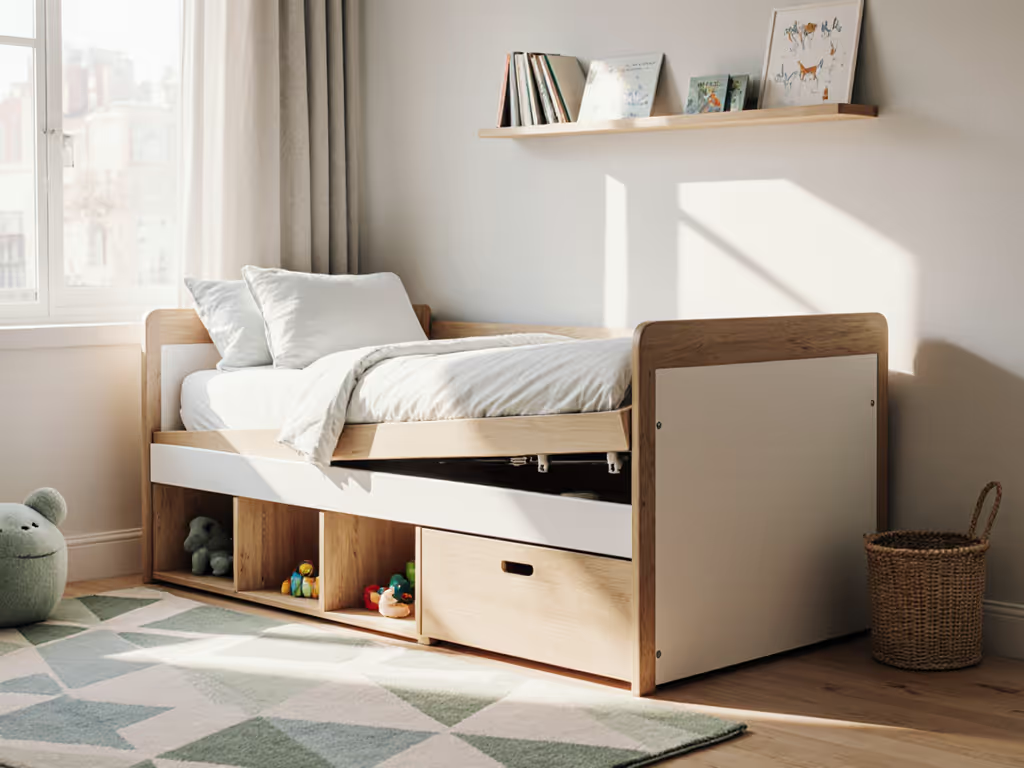
Did you know that the average child outgrows three beds before reaching their teenage years? For parents, finding a sleep solution that keeps up can save money and space while ensuring safety. Convertible beds for toddlers offer that rare mix of flexibility and longevity that busy families crave. Discover how these smart designs can simplify bedtime transitions and turn one investment into years of comfort for your growing child.
Key Takeaways
| Point | Details |
|---|---|
| Convertible Beds | Offer long-term solutions that adapt through various developmental stages, increasing utility. |
| Safety Features | Incorporate rigorous safety standards, ensuring child safety with solid construction and design. |
| Cost Effectiveness | Initially more expensive but save money by serving multiple functions, replacing several beds. |
| Space Efficiency | Ideal for small living spaces, these beds grow with your child, eliminating the need for frequent replacements. |
[Markdown Content Here]
Main Types of Convertible Beds for Toddlers
Navigating the world of convertible beds can feel overwhelming, but understanding the main types will help you make an informed decision for your growing toddler. These innovative sleep solutions come in several configurations designed to adapt as your child transitions through different developmental stages.
2-in-1 Convertible Beds: The Basic Transformation
The 2-in-1 convertible bed represents the most straightforward option for parents seeking initial flexibility. These beds start as a standard crib and can be converted into a toddler bed with side rails removed. This simple transformation allows parents to extend the bed's usability without purchasing an entirely new piece of furniture. Perfect for families just beginning their space-saving journey.
3-in-1 Convertible Beds: Enhanced Versatility
Step up the flexibility with 3-in-1 convertible beds, which offer an additional configuration beyond the basic crib and toddler bed. These models typically include:
- Standard crib mode
- Toddler bed configuration
- Daybed option for lounging or additional seating
The daybed feature provides extra functionality, making these beds an excellent choice for smaller rooms where multi-purpose furniture is crucial.
4-in-1 Convertible Beds: Maximum Long-Term Value
For parents thinking decades ahead, 4-in-1 convertible beds represent the ultimate investment. These comprehensive sleep solutions transform through four distinct stages:
- Infant crib
- Toddler bed
- Daybed
- Full-size bed for teenagers or young adults
While initially more expensive, 4-in-1 beds can potentially serve a child from birth through late teenage years, offering unparalleled long-term value and space efficiency. Just imagine one piece of furniture growing alongside your child—that's smart parenting.
Choosing the right convertible bed depends on your specific space constraints, budget, and long-term planning. Each type offers unique benefits, so consider your family's individual needs when making this important decision.
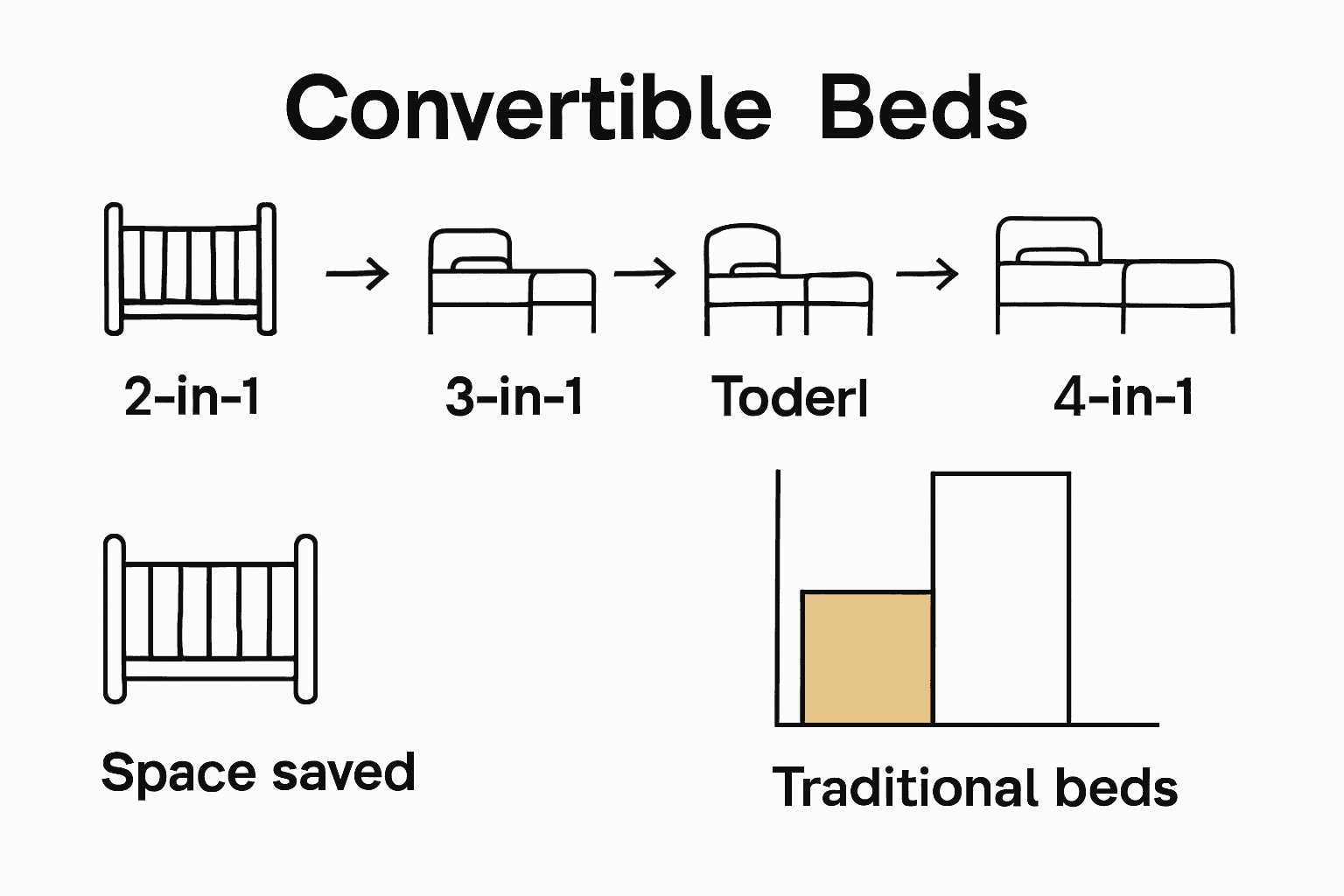
Here's a comparison of the main types of convertible beds:
| Type | Number of Configurations | Stages Covered | Ideal For |
|---|---|---|---|
| 2-in-1 Convertible | 2 | Crib<br>Toddler bed | Basic needs<br>Budget-conscious |
| 3-in-1 Convertible | 3 | Crib<br>Toddler bed<br>Daybed | Versatility<br>Small spaces |
| 4-in-1 Convertible | 4 | Crib<br>Toddler bed<br>Daybed<br>Full-size bed | Long-term use<br>Maximum value |
Key Features and How Convertible Beds Work
Convertible beds are engineering marvels of children's furniture, designed with incredible precision and thoughtful functionality. These adaptive sleep solutions aren't just beds—they're strategic investments that transform seamlessly as your child grows, offering parents remarkable flexibility and value.
Safety-First Structural Design
At the core of convertible beds are critical safety features that ensure child protection through every transition. Manufacturers incorporate precise engineering elements like:
- Fixed side rails with precise spacing (no more than 2 3/8 inches apart)
- Rounded edges to prevent potential injury
- Sturdy construction using non-toxic, child-safe materials
- Reinforced connection points for smooth conversion
Conversion Mechanism Explained
The magic of convertible beds lies in their modular conversion system. Each configuration requires specialized hardware and carefully designed attachment points that allow parents to modify the bed's structure safely. Typical conversion steps include:
- Removing protective side rails
- Adjusting mattress height
- Reconfiguring frame components
- Installing stage-specific safety features
Professional tip: Always use manufacturer-approved conversion kits and follow installation instructions precisely to maintain structural integrity.
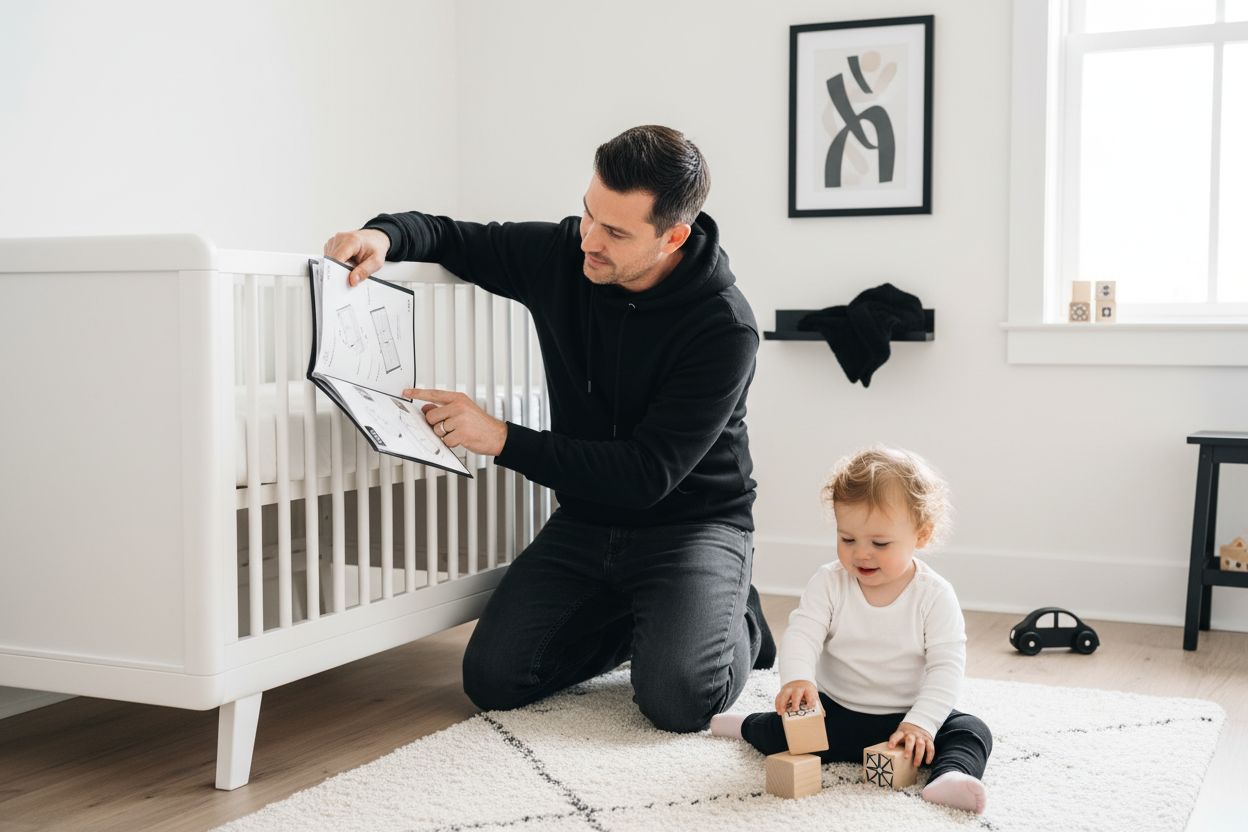
Mattress and Height Adaptability
One standout feature of convertible beds is their multi-height mattress support. Most models offer 3-4 different mattress height positions, allowing you to lower the sleeping surface as your child becomes more mobile. This adaptability serves two critical purposes:
- Prevents infant falls during early developmental stages
- Provides easy access for parents during nighttime care
By incorporating intelligent design and safety-conscious engineering, convertible beds represent far more than simple furniture—they're a comprehensive sleep solution that grows alongside your child, offering peace of mind and practical value for discerning parents.
Safety Standards and Durability Considerations
When it comes to convertible beds, safety isn't just a feature—it's the foundation. Parents need absolute confidence that their child's sleeping environment meets the highest standards of protection and structural integrity. Since 2011, federal regulations have dramatically transformed the landscape of children's furniture safety, establishing rigorous guidelines that manufacturers must follow.
Federal Safety Mandates
The U.S. Consumer Product Safety Commission has implemented comprehensive safety standards that convertible beds must meet, including:
- Elimination of drop-side rail designs
- Mandatory slat spacing no wider than 2 3/8 inches
- Specific corner post height restrictions
- Prohibition of hazardous cutouts or potential entrapment zones
- Requirement for manufacturer-approved conversion components
Construction Quality Matters
Durability goes hand-in-hand with safety in convertible beds. The most reliable models feature solid-wood construction, high-resistance finishes, and reinforced connection points. These design elements ensure the bed can withstand multiple conversions and years of active use. Think of it like buying a reliable car—you want something that can handle the journey.
Inspection and Maintenance
Even the highest-quality convertible bed requires ongoing attention. Parents should:
- Regularly check hardware connections
- Inspect for any signs of wear or stress
- Follow manufacturer's recommended maintenance schedule
- Replace conversion hardware as specified
A well-maintained convertible bed isn't just a piece of furniture—it's a long-term investment in your child's safety and comfort. By choosing a bed that meets stringent safety standards and maintaining it properly, you're creating a secure sleeping environment that can adapt and grow with your child.
Comparing Convertible Beds to Other Toddler Options
Choosing the right sleeping solution for your toddler isn't just about comfort—it's about making a strategic investment in your child's growing years. Convertible beds stand out as a remarkable option when compared to traditional toddler beds and other sleeping alternatives, offering unparalleled versatility and long-term value.
Cost and Longevity Comparison
When it comes to pure financial strategy, convertible beds shine. While the initial price tag might seem higher compared to standard toddler beds, these adaptable sleep solutions can actually save parents significant money over time. A typical convertible bed can serve your child from infancy through teenage years—essentially replacing 3-4 separate pieces of furniture with a single, adaptable unit.
Design and Functionality Differences
Traditional toddler beds often feature:
- Compact, lower-to-ground designs
- Themed or playful aesthetics
- Limited age-range functionality
- Shorter usage lifespan
In contrast, convertible beds offer:
- Multiple configuration options
- Seamless transitions between developmental stages
- More robust construction
- Potential to adapt from crib to full-size bed
Space Efficiency Evaluation
For parents navigating smaller living spaces, convertible beds represent an ingenious solution. Unlike single-purpose toddler beds that become obsolete after a few years, these innovative sleep systems grow alongside your child. The ability to transform from an infant crib to a toddler bed, and potentially a full-size bed, means you're not constantly replacing furniture—you're investing in a single, adaptable piece.
Ultimately, the choice between a convertible bed and traditional toddler options comes down to your family's specific needs, budget, and long-term planning. But for parents seeking maximum flexibility, durability, and value, convertible beds offer an unbeatable combination of practicality and smart design.
Discover Smarter Sleep Solutions for Growing Toddlers
If you are feeling overwhelmed by the challenge of creating a safe and space-saving sleep environment for your toddler, you are not alone. Many first-time parents worry about making the right choice when it comes to convertible beds, especially when safety, durability, and long-term value are at stake. Our article highlighted how types like 2-in-1, 3-in-1, and 4-in-1 convertible beds can transform as your child grows, but turning these insights into action can still feel confusing.
Ready for tailored guidance that saves you both space and stress? Visit City Toddler Beds for expert reviews, practical room setup ideas, and up-to-date advice about choosing the best convertible bed for your needs. Explore our curated guides and safety tips to empower your decision-making now. Take the next step toward a smarter, safer sleep space for your child today.
Frequently Asked Questions
What are the main types of convertible beds for toddlers?
The main types of convertible beds for toddlers include 2-in-1, 3-in-1, and 4-in-1 models, providing varying configurations such as crib, toddler bed, daybed, and even a full-size bed for older children.
How do I ensure the safety of a convertible bed?
To ensure safety, look for convertible beds that meet federal safety regulations, have fixed side rails, rounded edges, and sturdy construction materials. Regular inspections for wear and proper maintenance are also essential.
What are the advantages of a 4-in-1 convertible bed compared to a traditional toddler bed?
A 4-in-1 convertible bed offers longer usability as it transitions from an infant crib to a toddler bed, daybed, and full-size bed. In contrast, traditional toddler beds can quickly become obsolete, requiring replacement as your child grows.
How often should I check and maintain a convertible bed?
You should regularly check the connections and hardware of the convertible bed for any signs of wear and adhere to the manufacturer's recommended maintenance schedule to ensure safety and durability.

